整体架构
过程
编码器负责把自然语言序列映射成为隐藏层, 解码器把隐藏层再映射为自然语言序列。
- 输入自然语言序列到编码器:Why do we work?(为什么要工作);
- 通过编码器得到隐藏层,再输入到解码器;
- 输入<start>(起始)符号到解码器;
- 得到第一个字"为";
- 将得到的第一个字“为”落下来再输入到解码器;
- 得到第二个字”什";
- 将得到的第二字再落下来,直到解码器输出<𝑒𝑛𝑑>(终止符),即序列生成完成。
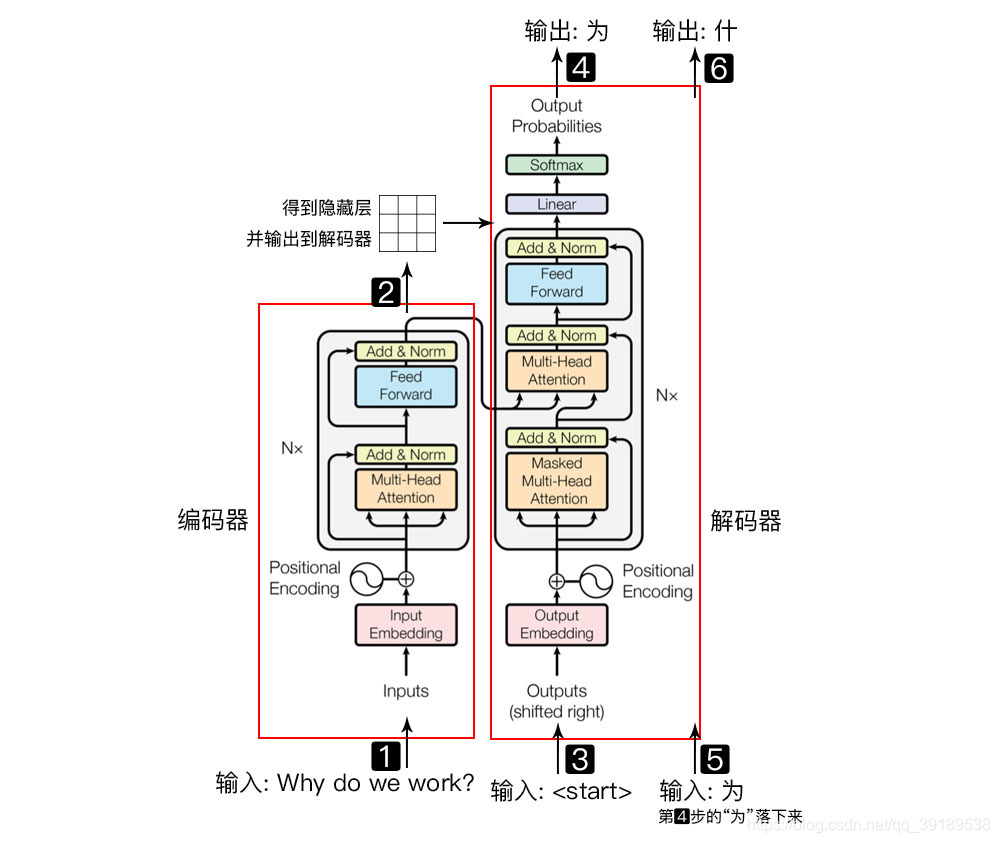
Transformer
class Transformer(nn.Module):
# model_dim: Embedding Size, ffn_dim: FeedForward dimension
# n_layers: number of Encoder of Decoder Layer, n_heads: number of heads in Multi-Head Attention
def __init__(self, src_vocab_size, src_max_len, tgt_vocab_size, tgt_max_len,
num_layers=6, num_heads=8, model_dim=512, ffn_dim=2048, dropout=0.0):
super(Transformer, self).__init__()
self.encoder = Encoder(src_vocab_size, src_max_len, num_layers, model_dim, num_heads, ffn_dim, dropout)
self.decoder = Decoder(tgt_vocab_size, tgt_max_len, num_layers, model_dim, num_heads, ffn_dim, dropout)
self.linear = nn.Linear(model_dim, tgt_vocab_size, bias=False)
self.softmax = nn.Softmax(dim=2)
def forward(self, src_seq, tgt_seq):
src_mask = get_pad_mask(src_seq).int()
tgt_mask = torch.gt((get_pad_mask(tgt_seq).int() + get_sequence_mask(tgt_seq).int()), 0).int()
enc_output, enc_self_attn = self.encoder(src_seq, src_mask)
dec_output, dec_self_attn, dec_enc_attn = self.decoder(tgt_seq, tgt_mask, enc_output, src_mask)
output = self.softmax(self.linear(dec_output))
return output, enc_self_attn, dec_self_attn, dec_enc_attn
Mask
Transformer 模型里面涉及两种mask,分别是 padding mask 和 sequence mask。
padding mask 由于对输入设置了最大的输入长度(max sequence length),因此对短于最大长度的输入序列会在其后面填充0。但是这些填充的位置并没无意义,attention 机制不应该把注意力放在这些位置上,因此可以把 m a s k = 1 mask = 1 mask=1 对应的输入位置加上一个非常大的负数(或负无穷),这样经过 softmax 这些位置的概率就会接近0。
def get_pad_mask(seq):
mask = (seq == 0).unsqueeze(-2)
return mask
sequence mask sequence mask 是为了使 decoder 不能看到未来的信息。对于一个序列,在 t 时刻解码输出只能依赖于 t 时刻之前的输出,而不能依赖 t之后的输出。可以构造一个矩阵,上三角的值全为1,下三角的值全为0,对角线也是0,值为1的位置即是加上负无穷的位置。
def get_sequence_mask(seq):
batch_size, seq_len = seq.size()
mask = torch.triu(torch.ones((seq_len, seq_len), dtype=torch.uint8), diagonal=1)
mask = mask.unsqueeze(0).expand(batch_size, -1, -1)
return mask
Positional Encoding
位置编码用于提供语言的位置顺序信息,论文使用了 sin 和 cos 函数的变换:
P E ( p o s , 2 i ) = s i n ( p o s / 1000 0 2 i / d model ) PE_{(pos,2i)} = sin(pos / 10000^{2i/d_{\text{model}}}) PE(pos,2i)=sin(pos/100002i/dmodel)
P E ( p o s , 2 i + 1 ) = c o s ( p o s / 1000 0 2 i / d model ) PE_{(pos,2i+1)} = cos(pos / 10000^{2i/d_{\text{model}}}) PE(pos,2i+1)=cos(pos/100002i/dmodel)
位置嵌入的维度为 ( m a x s e q u e n c e l e n g t h , e m d e d d i n g s i z e ) (max\ sequence\ length, emdedding \ size) (max sequence length,emdedding size), p o s pos pos 指的是句中字的位置,取值范围是 [ 0 , m a x s e q u e n c e l e n g t h ) [0, max \ sequence \ length) [0,max sequence length), i i i指的是词向量的维度,取值范围是 [ 0 , e m b e d d i n g s i z e ) [0, embedding \ size) [0,embedding size).
class PositionalEncoding(nn.Module):
def __init__(self, max_seq_length, embed_size):
super(PositionalEncoding, self).__init__()
pe = np.array([[(pos / np.power(10000, 2 * (i // 2) / embed_size))
for i in range(d_model)] for pos in range(max_seq_length)])
pe[:, 0::2] = np.sin(pe[:, 0::2])
pe[:, 1::2] = np.cos(pe[:, 1::2])
pe = torch.FloatTensor(pe).unsqueeze(0) # (1, max_seq_length, d_model)
self.register_buffer("pe", pe)
def forward(self, x):
# x: input--(batch size, max squence length)
# return (batch size, max seq length, emdedding size)
return self.pe[:, :x.size(1), :].clone().detach()
Mutil-Head Attention
Scaled Dot-Product Attention
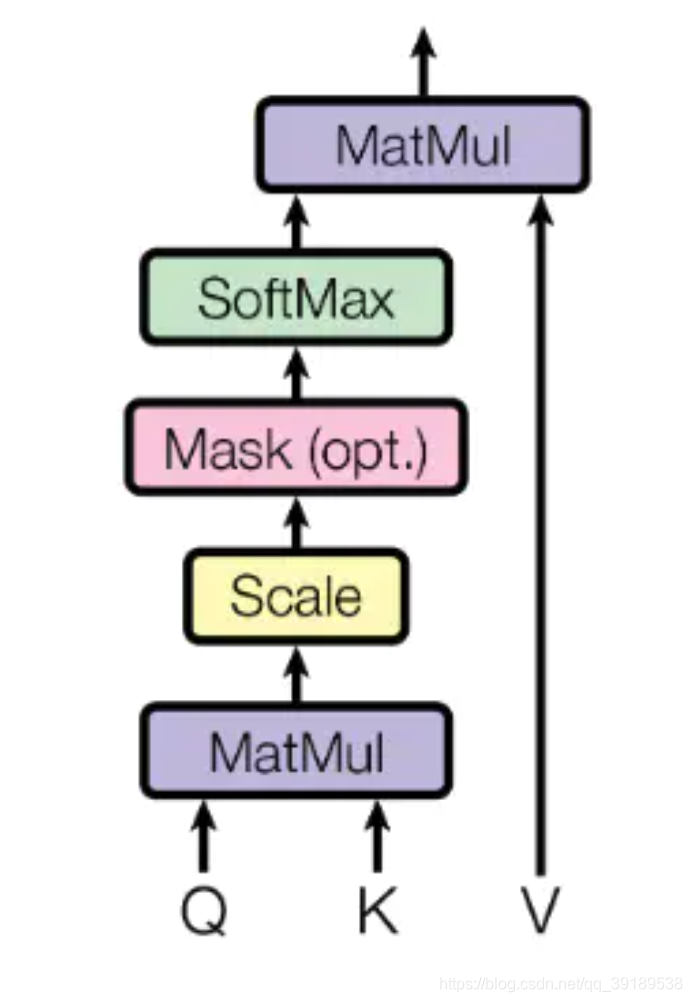
X e m b e d d i n g = E m b e d d i n g L o o k u p ( X ) + P o s i t i o n a l E n c o d i n g ( X ) X_{embedding}=EmbeddingLookup(X) + PositionalEncoding(X) Xembedding=EmbeddingLookup(X)+PositionalEncoding(X),其维度为 ( b a t c h s i z e , m a x s e q u e n c e l e n g t h , e m b e d d i n g s i z e ) (batch\ size, max \ sequence \ length, embedding \ size) (batch size,max sequence length,embedding size).
A t t e n t i o n ( Q , K , V ) = s o f t m a x ( Q K T d k ) V Attention(Q,K,V)=softmax(\frac{QK^T}{\sqrt{d_k}})V Attention(Q,K,V)=softmax(dkQKT)V
-
在 encoder 的 self-attention 中,Q、K、V 都来自上一层 encoder 的输出。对于第一层 encoder,其输入为 X e m b e d d i n g X_{embedding} Xembedding.
-
在 decoder 的 self-attention 中,Q、K、V 都来自上一层 decoder 的输出。对于第一层 decoder,其输入为 X e m b e d d i n g X_{embedding} Xembedding,但是对于decoder,不希望它能获得下一个时间步的信息,因此需要进行 sequence masking.
-
在 encoder-decoder attention 中,Q 来自 decoder 的上一层输出,K、V 来自 encoder 的输出.
class ScaledDotProductAttention(nn.Module):
def __init__(self, dropout=0.2):
super(ScaledDotProductAttention, self).__init__()
self.softmax = nn.Softmax(dim=2)
self.dropout = nn.Dropout(dropout)
def forward(self, q, k, v, scale=None, mask=None):
# q,k,v (batch size, max seq length, embedding size)
# attention (batch size, max seq length, max seq length)
attention = torch.bmm(q, k.transpose(1, 2))
if scale:
attention = attention * scale
if mask is not None:
attention = attention.masked_fill_(mask.bool(), -np.inf)
attention = self.dropout(self.softmax(attention))
# context (batch size, max seq length, embedding size)
context = torch.bmm(attention, v)
return context, attention
Mutil-Head Attention
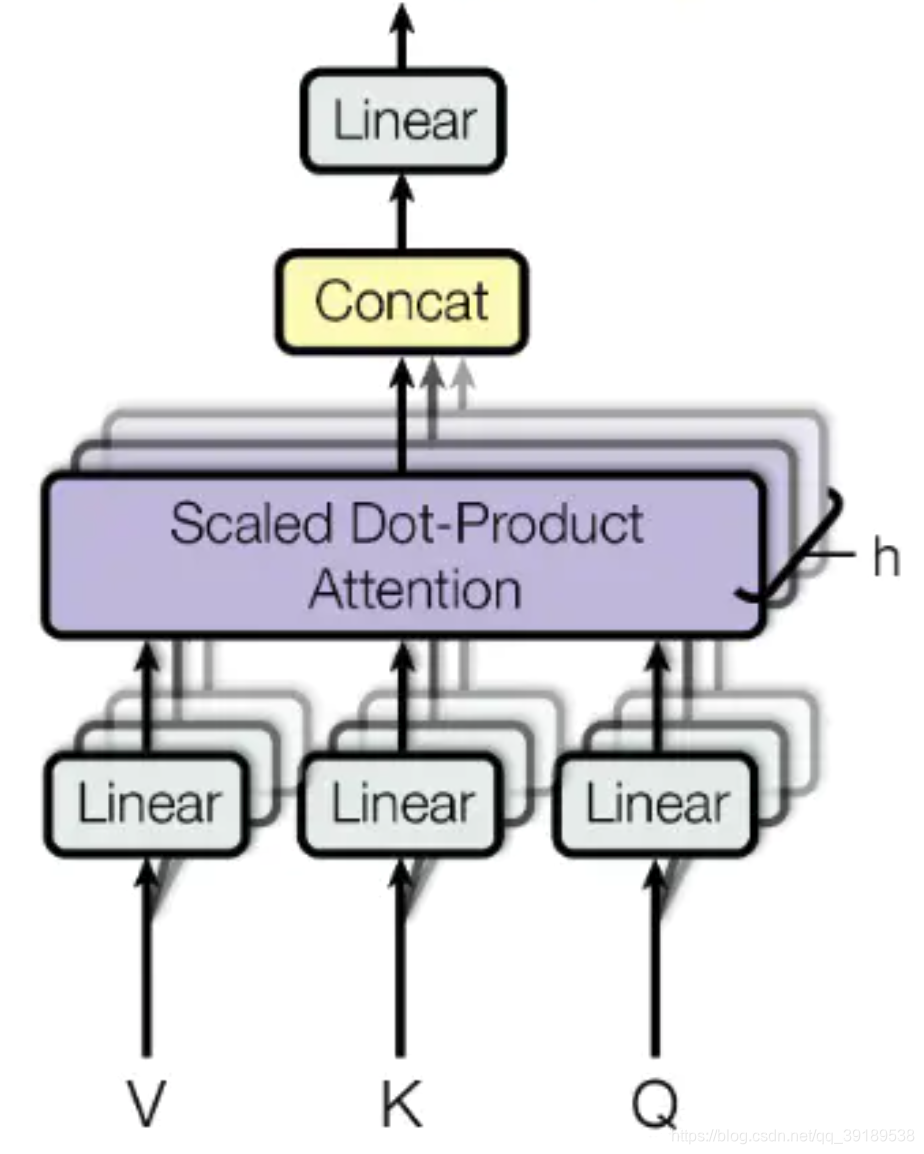
Q = L i n e a r ( X e m b e d d i n g ) = X e m b e d d i n g W Q Q=Linear(X_{embedding})=X_{embedding}W_Q Q=Linear(Xembedding)=XembeddingWQ
K = L i n e a r ( X e m b e d d i n g ) = X e m b e d d i n g W K K=Linear(X_{embedding})=X_{embedding}W_K K=Linear(Xembedding)=XembeddingWK
V = L i n e a r ( X e m b e d d i n g ) = X e m b e d d i n g W V V=Linear(X_{embedding})=X_{embedding}W_V V=Linear(Xembedding)=XembeddingWV
M u t i l H e a d ( Q , K , V ) = C o n c a t ( h e a d 1 , … h e a d n ) W O MutilHead(Q,K,V) =Concat(head_1,…head_n)W_O MutilHead(Q,K,V)=Concat(head1,…headn)WO
Q 、 K 、 V Q、K、V Q、K、V ( b a t c h s i z e , m a x s e q u e n c e l e n g t h , e m b e d d i n g s i z e ) (batch\ size, max \ sequence \ length, embedding \ size) (batch size,max sequence length,embedding size), W Q , W K , W V , W O W_Q, W_K, W_V, W_O WQ,WK,WV,WO ( e m b e d d i n g s i z e , e m b e d d i n g s i z e ) (embedding \ size, embedding \ size) (embedding size,embedding size).
将 Q 、 K 、 V Q、K、V Q、K、V 通过一个线性映射之后把 e m b e d d i n g s i z e embedding \ size embedding size分成 h h h 份,对每一份进行 Scaled Dot-Product Attention。然后,把各个部分的结果合并起来再经过线性映射,得到最终的输出。
class MultiHeadAttention(nn.Module):
def __init__(self, model_dim=512, num_heads=8, dropout=0.2):
super(MultiHeadAttention, self).__init__()
self.dim_per_head = model_dim // num_heads
self.num_heads = num_heads
self.linear_q = nn.Linear(model_dim, self.dim_per_head * num_heads)
self.linear_k = nn.Linear(model_dim, self.dim_per_head * num_heads)
self.linear_v = nn.Linear(model_dim, self.dim_per_head * num_heads)
self.attention = ScaledDotProductAttention(dropout)
self.linear = nn.Linear(model_dim, model_dim)
self.dropout = nn.Dropout(dropout)
self.layer_norm = nn.LayerNorm(model_dim)
def forward(self, q, k, v, mask=None):
residual = q
dim_per_head = self.dim_per_head
num_heads = self.num_heads
batch_size = q.size(0)
# linear projection
q = self.linear_q(q)
k = self.linear_k(k)
v = self.linear_v(v)
# split by num_heads
q = q.view(batch_size * num_heads, -1, dim_per_head)
k = k.view(batch_size * num_heads, -1, dim_per_head)
v = v.view(batch_size * num_heads, -1, dim_per_head)
if mask is not None:
mask = mask.repeat(num_heads, 1, 1)
scale = (q.size(-1) // num_heads) ** -0.5
context, attention = self.attention(q, k, v, scale, mask)
# concat heads
context = context.view(batch_size, -1, dim_per_head * num_heads)
output = self.dropout(self.linear(context))
output = self.layer_norm(residual + output)
return output, attention
Attention 的含义
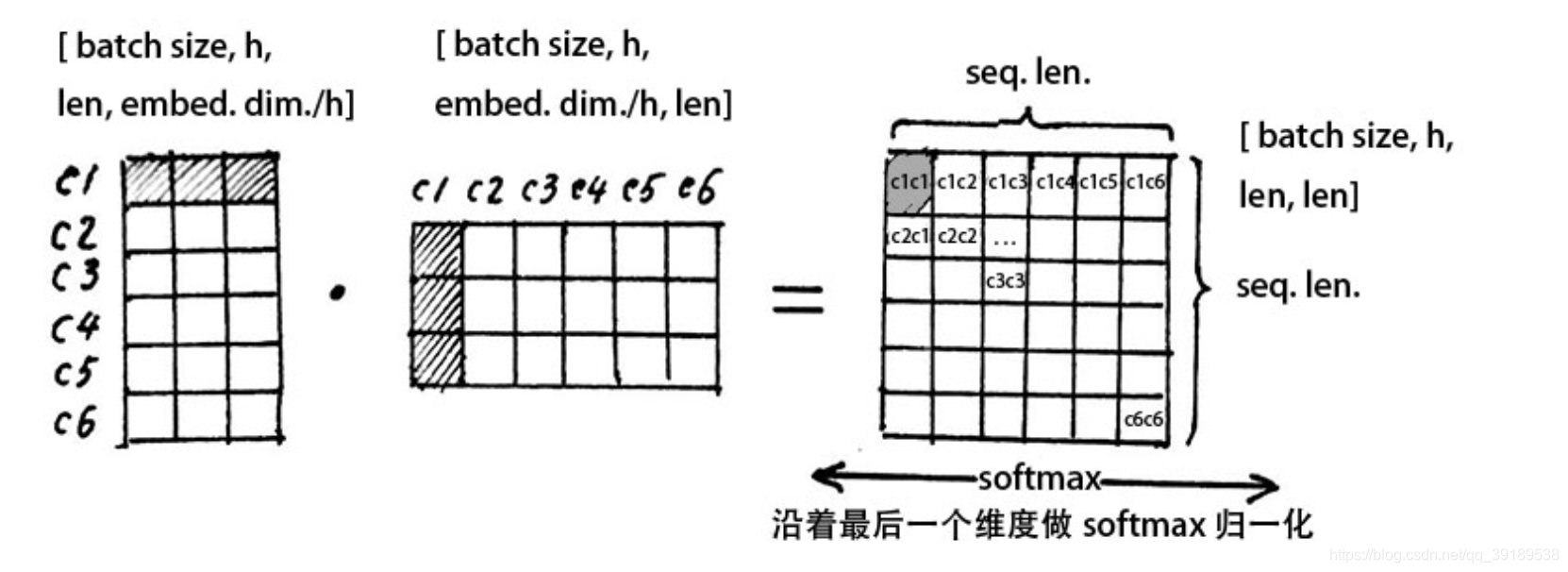

s o f t m a x ( Q K T d k ) V softmax(\frac{QK^T}{\sqrt{d_k}})V softmax(dkQKT)V
先计算 Q 、 K Q、K Q、K 的点积,两个向量越相似,其点积越大。比如第一个字与第一个字的点积,即 c 1 c1 c1行与 c 1 c1 c1列相乘得到的 c 1 c 1 c1c1 c1c1,代表了第一个字的注意力机制,注意力矩阵的第一行指的是第一个字与所有6个字的相似度。
然后再点乘 V V V的列,从而使得每个字向量都含有当前句子所有字向量的全部信息。
Position-wise FeedForward Network
这是一个全连接网络,包含两个线性变换和一个非线性函数(ReLU)。
F F N ( x ) = m a x ( 0 , x W 1 + b 1 ) W 2 + b 2 FFN(x)=max(0,xW_1+b_1)W_2+b_2 FFN(x)=max(0,xW1+b1)W2+b2
输入 x x x ( b a t c h s i z e , m a x s e q u e n c e l e n g t h , m o d e l d i m ) (batch\ size, max \ sequence \ length, model \ dim) (batch size,max sequence length,model dim)
W 1 W_1 W1 ( m o d e l d i m , f f n d i m ) (model \ dim, ffn \ dim) (model dim,ffn dim)
W 2 W2 W2 ( f f n d i m , m o d e l d i m ) (ffn \ dim, model \ dim) (ffn dim,model dim)
输出 ( b a t c h s i z e , m a x s e q u e n c e l e n g t h , m o d e l d i m ) (batch\ size, max \ sequence \ length, model \ dim) (batch size,max sequence length,model dim)
class PositionalWiseFeedForward(nn.Module):
def __init__(self, model_dim=512, ffn_dim=2048, dropout=0.2):
super(PositionalWiseFeedForward, self).__init__()
self.linear1 = nn.Linear(model_dim, ffn_dim)
self.relu = nn.ReLU()
self.linear2 = nn.Linear(ffn_dim, model_dim)
self.dropout = nn.Dropout(dropout)
self.layer_norm = nn.LayerNorm(model_dim)
def forward(self, x):
residual = x
x = self.relu(self.linear1(x))
x = self.dropout(self.linear2(x))
output = self.layer_norm(x + residual)
return output
Encoder
EncoderLayer
EncoderLayer 的每一层都由两部分组成:第一部分是 Multi-Head Self-Attention Mechanism,第二部分是 Position-Wise Feed Forward Network,这两部分都有一个 Residual Connection 和 Layer Normalization.
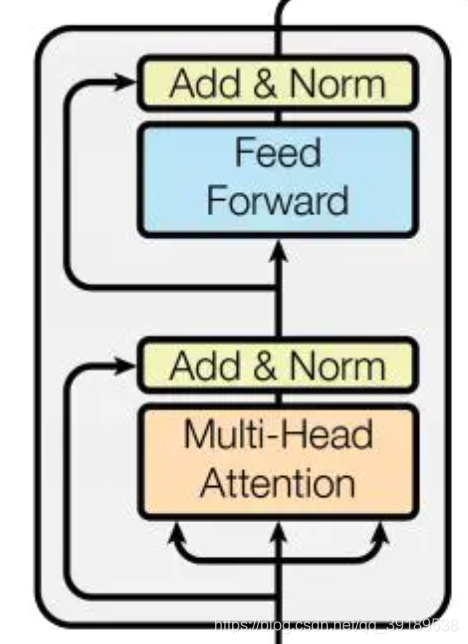
class EncoderLayer(nn.Module):
def __init__(self, model_dim=512, num_heads=8, ffn_dim=2048, dropout=0.2):
super(EncoderLayer, self).__init__()
self.attention = MultiHeadAttention(model_dim, num_heads, dropout)
self.feed_forward = PositionalWiseFeedForward(model_dim, ffn_dim, dropout)
def forward(self, enc_inputs, enc_self_attn_mask=None):
context, attention = self.attention(enc_inputs, enc_inputs, enc_inputs, enc_self_attn_mask)
output = self.feed_forward(context)
return output, attention
Encoder
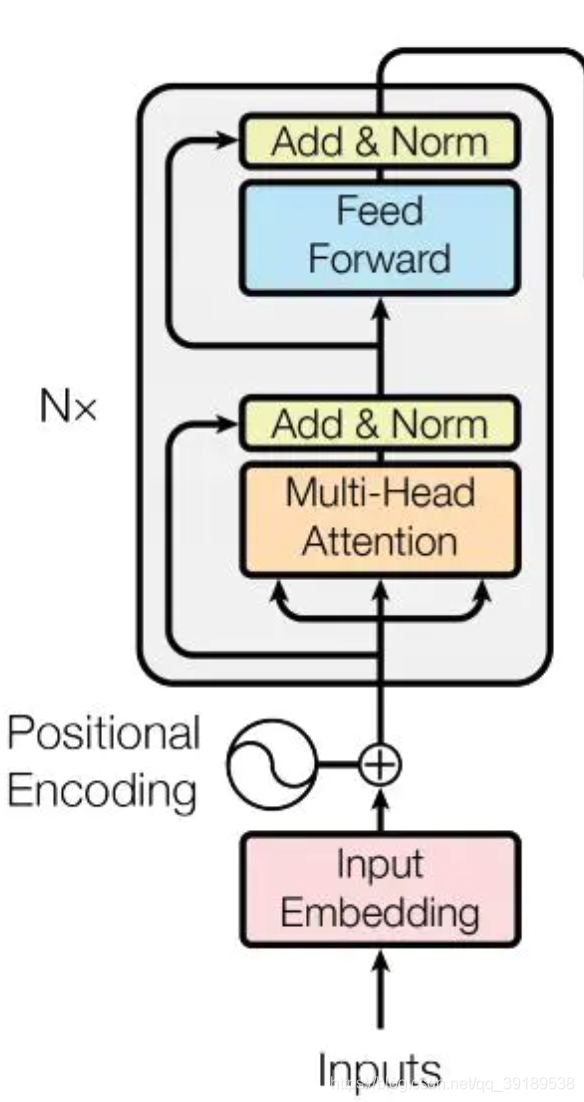
class Encoder(nn.Module):
def __init__(self, vocab_size, max_seq_length, num_layers=6, model_dim=512,
num_heads=8, ffn_dim=2048, dropout=0.2):
super(Encoder, self).__init__()
self.word_embed = nn.Embedding(vocab_size, model_dim, padding_idx=0)
self.pos_embed = PositionalEncoding(max_seq_length, model_dim)
self.dropout = nn.Dropout(dropout)
self.layer_norm = nn.LayerNorm(model_dim)
self.layer_stack = nn.ModuleList([EncoderLayer(model_dim, num_heads, ffn_dim, dropout)
for _ in range(num_layers)])
def forward(self, inputs, slf_attn_mask):
embed = self.word_embed(inputs) + self.pos_embed(inputs)
output = self.layer_norm(self.dropout(embed))
attentions = []
for encoder in self.layer_stack:
output, attention = encoder(output, slf_attn_mask)
attentions.append(attention)
return output, attentions
Decoder
DecoderLayer
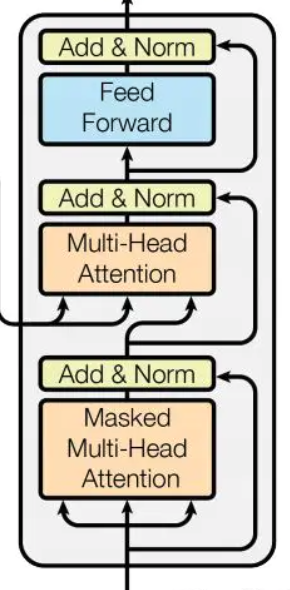
DecoderLayer 每一个层包括以下3个部分:第一个部分是 multi-head self-attention mechanism,第二部分是 multi-head context-attention mechanism,第三部分是 position-wise feed-forward network,这三个部分的每一个部分都有一个 residual connection 和 Layer Normalization.
class DecoderLayer(nn.Module):
def __init__(self, model_dim=512, num_heads=8, ffn_dim=2048, dropout=0.2):
super(DecoderLayer, self).__init__()
self.self_attn = MultiHeadAttention(model_dim, num_heads, dropout)
self.dec_enc_attn = MultiHeadAttention(model_dim, num_heads, dropout)
self.feed_forward = PositionalWiseFeedForward(model_dim, ffn_dim, dropout)
def forward(self, dec_inputs, enc_outputs, slf_attn_mask=None, dec_enc_attn_mask=None):
# self attention: all inputs are decoder inputs
dec_outputs, self_attn = self.self_attn(dec_inputs, dec_inputs, dec_inputs, slf_attn_mask)
# context attention: query is decoder's outputs, key and value are encoder's inputs
dec_outputs, dec_enc_attn = self.dec_enc_attn(dec_outputs, enc_outputs, enc_outputs, dec_enc_attn_mask)
dec_outputs = self.feed_forward(dec_outputs)
return dec_outputs, self_attn, dec_enc_attn
Decoder
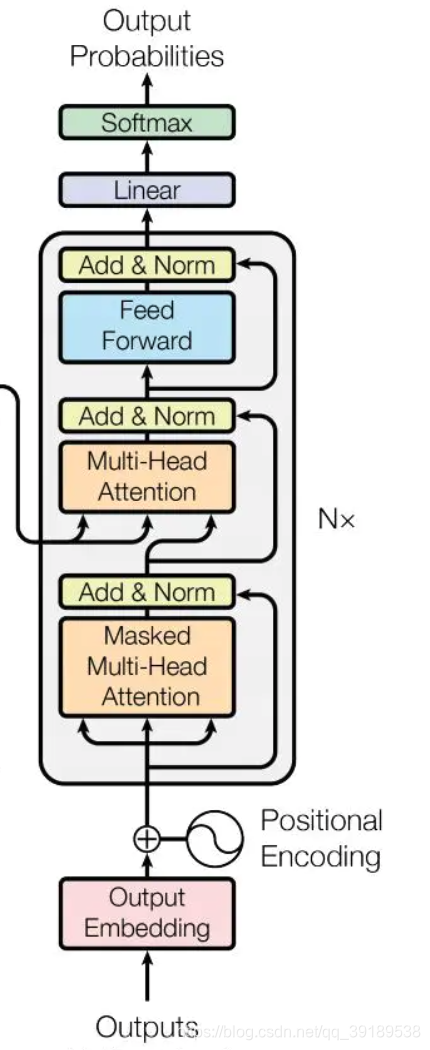
class Decoder(nn.Module):
def __init__(self, vocab_size, max_seq_length, num_layers=6, model_dim=512,
num_heads=8, ffn_dim=2048, dropout=0.2):
super(Decoder, self).__init__()
self.word_embed = nn.Embedding(vocab_size, model_dim, padding_idx=0)
self.pos_embed = PositionalEncoding(max_seq_length, model_dim)
self.dropout = nn.Dropout(dropout)
self.layer_norm = nn.LayerNorm(model_dim)
self.layer_stack = nn.ModuleList([DecoderLayer(model_dim, num_heads, ffn_dim, dropout)
for _ in range(num_layers)])
def forward(self, tgt_seq, tgt_mask, enc_outputs, src_mask):
embed = self.word_embed(tgt_seq) + self.pos_embed(tgt_seq)
dec_outputs = self.layer_norm(self.dropout(embed))
self_attns, dec_enc_attns = [], []
for decoder in self.layer_stack:
dec_outputs, self_attn, dec_enc_attn = decoder(dec_outputs, enc_outputs, slf_attn_mask=tgt_mask, dec_enc_attn_mask=src_mask)
self_attns.append(self_attn)
dec_enc_attns.append(dec_enc_attn)
return dec_outputs, self_attns, dec_enc_attns
参考资料
https://juejin.im/post/5b9f1af0e51d450e425eb32d#heading-13
https://github.com/jadore801120/attention-is-all-you-need-pytorch






















 2026
2026

 被折叠的 条评论
为什么被折叠?
被折叠的 条评论
为什么被折叠?








